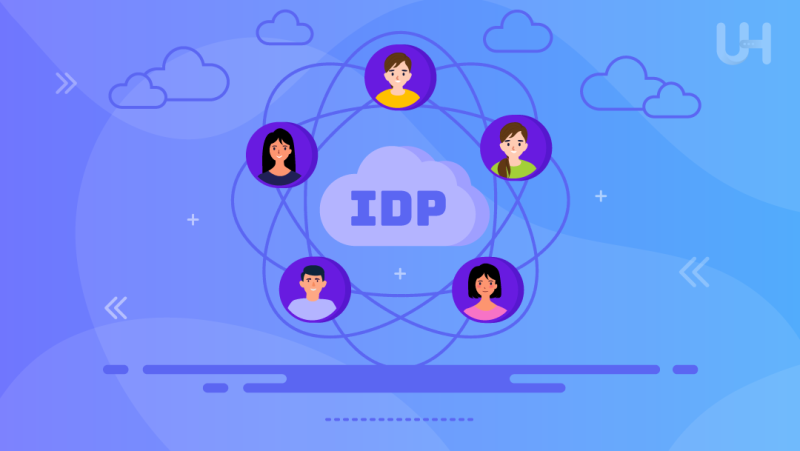Modern information space is largely based on secure and efficient identity management systems, which allow users to access different online services seamlessly. An Identity Provider, or IdP, steps into the picture—an entity responsible for maintaining and validating users’ identities on behalf of applications, websites, and services. Whether accessing your e-mail, work application, or social networking site, the process behind the curtains will more likely involve an IdP.
In this article, we will explore identity providers in depth, explaining their functions and benefits, examining their types, and revealing how they work in Single Sign-On and their security benefits. By the end, you will thoroughly understand how an identity provider works and why it is such an important component of the digital world.
What is IdP?
IdP means an identity provider-a system or service holding, authenticating, and managing user identity information. Simply put, it will be a trusted intermediary between the user and the service he aims to use. It will be confirmed to the systems if these users are who they say they are for access based on credential levels.
IdPs will handle the difficult task of authenticating users through passwords, biometrics, or two-factor authentication, among other methods. Once authentication is successful, the IdP issues a token or credential that might be used later by the same user to enable access with no further requirement for logging on. This part of the process is fundamental in creating continuity and security within the realm of user experiences.
What is User Identity?

User identity is the unique conjunction of attributes, credentials, and data representing an individual in a digital ecosystem, including information like usernames and passwords, email addresses, personal details, and behavioral traits such as browsing history or login pattern. These identifiers collectively provide authenticity to a user, ensuring his recognition and authorization for access to certain applications, platforms, or services.
The right infrastructure is crucial for security and performance when managing user identity in online platforms or services. Managed VPS hosting services provide a secure and reliable environment for handling sensitive user data, ensuring that identity management systems run smoothly. These services offer both scalability and enhanced security measures, ideal for organizations looking to safeguard user identity while maintaining seamless access and interaction.
Digital user identity has to do with quantifiable factors, which a computer system may verify. These are commonly referred to as “authentication factors,” and they basically fall into three categories:
- Knowledge: Something you know, like a username and password.
- Possession: Something you have, a smartphone or a security token.
- Intrinsic Attributes: Something you are, such as a fingerprint or retina scan.
An IdP may use one or more of these authentication factors to authenticate a user. If more than one factor is used, this is known as multi-factor authentication. By combining these elements, IdPs strengthen security so that only the rightful user can access protected systems and services. This approach secures sensitive information and instills confidence in the digital interactions between users and organizations.
Why Are IdPs Necessary?
The increased use of digital services has resulted in many user accounts and a number of passwords. This multiple set of credentials is irritating for users and a severe risk for organizations. IdPs prove to be very valuable at this point. They centralize user authentication, reduce the need for multiple logins, and improve data security by reducing the usage of weak passwords.
Moreover, IdPs allow trust between users and service providers; as neutral third parties, they ensure the secure handling of user credentials. This increases user confidence, while service providers are freed up to concentrate on their core competencies without investing much in authentication systems.
Types of Identity Providers
Identity providers are available in several forms designed to serve specific needs. Let’s look into the most common types:
Enterprise Identity Providers
Enterprise IdPs are designed for organizations to manage employee access to internal and external resources. They integrate with directory services like Microsoft Active Directory or cloud-based solutions such as Okta. These IdPs are highly secure and scalable, thus becoming ideal for large businesses.
Social IdPs enable users to log in to services using their social media credentials. Examples of social IdPs include Google, Facebook, and LinkedIn. This makes life easier for the user and expands service reach by utilizing accounts already in common use.
Government Identity Providers
Government IdPs primarily validate citizens’ identities to access certain public services, such as tax filing or healthcare portals. They use highly secure methods to provide authenticity, including biometrics. An example would be the Gov.uk Verify service in the UK.
Elevate Your Digital Security With IP Dedicated Server!
Are you looking for a secure and reliable solution to manage user identities? Pairing a robust Identity Provider (IdP) system with IP Dedicated Server Hosting from UltaHost ensures unmatched performance, scalability, and security.
Blockchain-based Identity Providers
Coming out as the decentralized counterpart, blockchain-based IdPs store user identities in distributed ledgers. Systems such as these offer greater levels of data privacy and control because users can manage their own credentials without needing to rely on a central authority. Examples are Sovrin and uPort.
How Does IdP Work?
Identity providers work in conjunction through a series of processes that help authenticate users to access several services easily. Here’s a step-by-step breakdown:
- User Requests Access: The user attempts to access some application or service that uses an IdP for authentication.
- Redirection to IdP: The service redirects the user to the authentication webpage of the identity provider.
- User-level Authentication: The IdP authenticates the user using one of the selected methods: password, biometric scanning, or multi-factor authentication.
- Token Issuance: The Identity Provider issues a token upon successful user authentication, which is secure and further used to assert the identity.
- Service Access: The token is returned to the service provider, allowing the user to access the requested resource without subsequent login.
- Session Management: IdP maintains the user’s session to enable continuous access to different services within the same ecosystem.
The Role of IdPs Within SSO
Identity providers are central to the functionality of Single Sign-On (SSO). An IdP manages and authenticates user identities, streamlining the login process for multiple services. Here’s how IdPs operate, particularly in environments where services like VDS hosting for efficient and secure access management:
- Authentication: This means that the user’s identity is verified at login time, carried out by an IdP. This ensures that credentials are valid and secure.
- Token Issuance: After authenticating the user, the IdP issues a token that allows access to various applications, eliminating further logins to each application.
- User Administration: IdP maintains user profiles, updates them, and secures them for continued easy interaction.
In other words, it acts like an IdP gatekeeper, enabling users to access every other service conveniently and securely with a single set of credentials.
Security Benefits of Using an Identity Provider
The integration of an identity provider into the authentication framework yields a number of security-related benefits:
- Centralized Authentication: This reduces the attack surface since fewer credentials will be stored at various places.
- Multi-Factor Authentication: This provides a higher level of security by requiring multiple means of verification.
- Tokenization: Reduces credential theft through the use of secure tokens.
- Compliance: Ensures data protection regulation, such as CCPA or GDPR hosting.
- Real-time Monitoring: It identifies suspicious login activity for proactive action.
- Password-less Authentication: Secure ways of logging in, such as biometrics reduce password dependency.
Identity Provider Examples
Several identity providers cater to diverse needs across industries. Notable examples include:
- Okta: A leading enterprise IdP offering cloud-based identity solutions.
- Microsoft Azure AD: Popular among businesses for its robust integration with Microsoft services.
- Google Identity: Widely used for personal and social authentication.
- Ping Identity: Renowned for its security-focused enterprise identity solutions.
- Auth0: Provides flexible identity management for developers and businesses.
- Sovrin: A blockchain-based IdP emphasizing decentralized identity.
Conclusion
An IDP acts as the backbone of all modern authentication systems. Through efficient and secure identity and access management, users can safely access any digital service. IdPs enhance one’s digital experience by allowing seamless authentications that guarantee security for personal data. Since businesses and people continue to adopt online platforms quickly, the importance of an identity provider will rise in shaping a secure and connected future.
Understanding the role of an Identity Provider (IdP) is crucial for securing your online systems and ensuring seamless user authentication. Consider a fast VPS from UltaHost to handle your security needs easily and reliably for optimal performance and speed when managing your IdP services.
FAQ
What is an Identity Provider (IdP)?
An Identity Provider (IdP) is a system that authenticates and verifies users’ identities before granting them access to applications or services.
How does an IdP work?
IdP stores and manages user credentials, providing application authentication services via protocols like SAML or OAuth.
Why do businesses use an IdP?
IdPs streamline user authentication, improve security, and allow single sign-on (SSO) to access multiple services with one login.
Is an IdP different from a Service Provider (SP)?
Yes, while an IdP authenticates users, an SP relies on the IdP for authentication and grants access to its services.
What are the benefits of using an IdP?
IdPs enhance security, reduce password fatigue, simplify user management, and improve the user experience with SSO.
Can an IdP be used with cloud applications?
Yes, IdPs are commonly used to provide secure access to cloud applications by authenticating users across multiple platforms.
What protocols do IdPs use for authentication?
IdPs typically use protocols like SAML, OpenID Connect, and OAuth to securely authenticate and authorize users.












